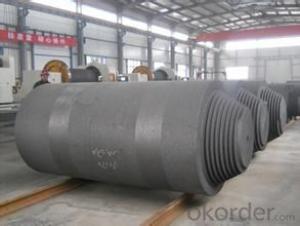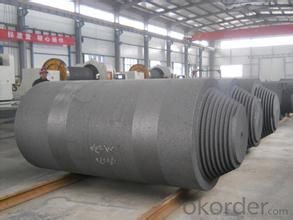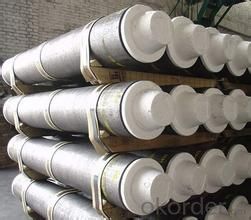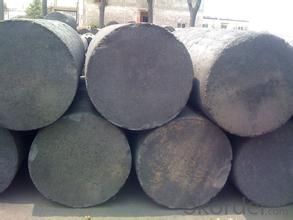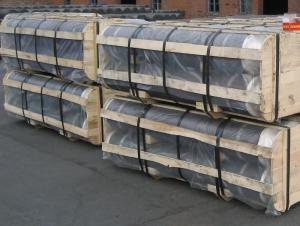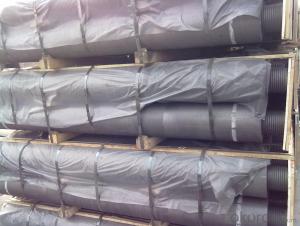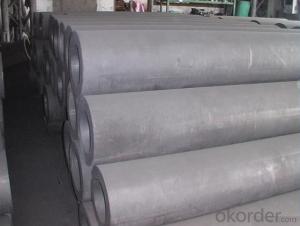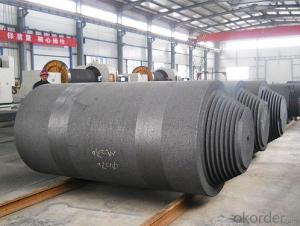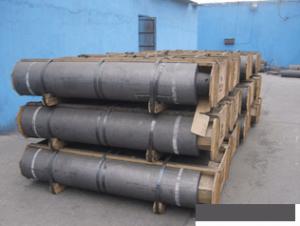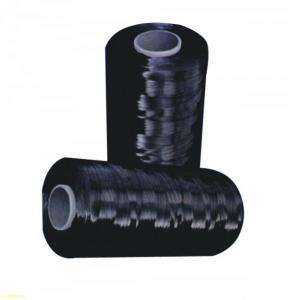Carbon Electrodes with Diameter Φ750~Φ960 RS 38 max
- Loading Port:
- Lianyungang
- Payment Terms:
- TT OR LC
- Min Order Qty:
- 20 m.t.
- Supply Capability:
- 700 m.t./month
OKorder Service Pledge
OKorder Financial Service
You Might Also Like
Spcifications
1:carbon eletrode
2:for ferroalloy,calcium carbide, silicon metal, manufacture
Product Description
Carbon Electrode is abaked electrode used in submerged arc furnaces for delivering power to the charge mix. Electrode is added to the top of the electrode column cylindrical form. Electrode is essentially a mix of Electrically Calcined Anthracite (ECA) or Calcined Petroleum Coke (CPC) with Coal Tar Pitch and is baked for weeks, it is widly used for ferroally productiong, silicon metal production etc.
Graphite/Carbon Electrode Paste Specification:
| PARAMETER UNIT GUARANTEE VALUE | ||||||
| Items | Φ500~Φ700 | Φ750~Φ960 | Φ1020~Φ1400 | |||
| Rs μΩ.m | ≤45 | ≤38 | ≤45 | ≤38 | ≤40 | |
| Bulk Desity g/cm3 | ≥1.55 | ≥1.58 | ≥1.55 | ≥1.58 | ≥1.55 | ≥1.58 |
| Bending Strength MPa | 3.5~7.5 | 4.0~7.5 | 3.5~7.5 | 4.0~7.5 | 3.5~7.5 | 4.0~7.5 |
| Compressive Strength MPa | ≥20.0 | ≥20.0 | ≥20.0 | ≥20.0 | ≥19.0 | ≥19.0 |
| Compressive Strength MPa | 3.2~4.8 | 3.0~4.6 | 3.2~4.8 | 3.0~4.6 | 3.2~4.8 | 3.0~4.6 |
| Ash % | ≤2.5 | ≤2.0 | ≤2.5 | ≤2.0 | ≤2.5 | ≤2.0 |
Picture:
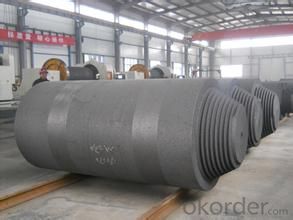
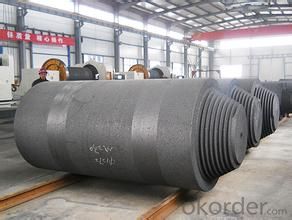
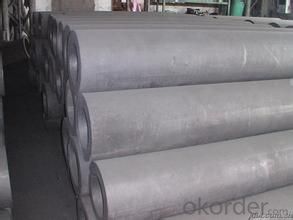
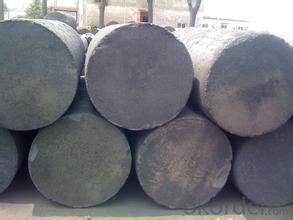
We can adjust the size based on different enquiry. please contact us if you are interested in this materials, we will send our offer as soon as get your kind email.
company information:
China National Building Materials Group is a stated -owned enterprise in charge of administrative affairs in China buiding materials industry.Established in 1984 CNBM is a large group corporation of building materials with total assets of 25 billion and a total stuff of 30000 CNBM now owns 200 subordinating firms of solely owned and joint-venture companies.
- Q: Yes, I have a weapon, want to strengthen 11, said to be advanced furnace rock carbon, do not know how to get, look at the prawns pointing
- To strengthen the ordinary senior rock colorless, furnace carbon is used advanced, the mall did not buy, according to that wish gift box can be opened in some special activities in the last device can be bought in, no other time
- Q: How do you remove car carbon?
- 3, running high speed can flush carbon deposition? Running high speed, you can really use the airflow on the airway erosion, wash away part of the carbon deposition. So, if you happen to go out, there are high-speed, national road two choices, you may choose to pull back to speed. But, Ma director thinks, if be in order to "flush carbon deposit" specially, want to run high speed, do not have this necessity. "It is a waste of time, and the cost of oil, extra high speed tolls, the effect is better to do a maintenance 4S shop!" 4, improve the shift speed, such as the original speed 2000rpm shift, modified 2500rpm conversion, generated can prevent carbon deposition, but also to protect the engine? Ma director said, low speed the shift, is often said that the "drag block", the car is easy to knock, the combustion of gasoline is not sufficient to carbon deposition. But it's not necessary for people to increase gear speed - that will increase fuel consumption and cause premature wear of clutch friction plates. So, manual transmission of the car, 1.6 ~ 2.0L displacement, about 2000 rpm shift is more economical, and no need to improve; and automatic car, pay attention not to slam the gas.
- Q: Isotopes of carbon
- There are three kinds of nature of carbon isotope, stable isotopes of 12C, 13C and 14C 14C of the radioactive isotope, the half-life is 5730 years, the application of 14C mainly has two aspects: one is the determination of biological death in archaeology, radioactive dating method; the two is labeled with 14C compound as a tracer, exploration the micro motion of chemistry and life science.
- Q: How is carbon used in the production of textiles?
- Textile production utilizes carbon in multiple ways, encompassing the utilization of carbon fibers, activated carbon, carbon black, and carbon nanotubes. Carbon fibers, for instance, serve as a lightweight and sturdy reinforcement for fabrics, enhancing their durability and performance. Activated carbon, known for its porous nature, finds extensive use in the textile industry due to its ability to adsorb and eliminate undesirable odors and chemicals. Consequently, it is employed in the manufacturing of sportswear, workwear, and specialized textiles where odor control is crucial. Additionally, carbon black, a finely powdered substance composed of carbon particles, functions as a pigment in textile printing and dyeing. By imparting a deep black hue, it is widely employed in the production of garments, upholstery, and other textiles requiring a dark coloration. Moreover, the development of carbon nanotextiles represents an innovative application of carbon in the textile realm. These textiles, fabricated from carbon nanotubes, exhibit exceptional properties such as high electrical conductivity and thermal stability. Consequently, they are ideal for applications involving wearable electronics, smart textiles, and conductive fabrics. In conclusion, carbon's incorporation into textiles through the integration of carbon fibers, activated carbon, carbon black, and carbon nanotubes contributes significantly to the strength, durability, odor control, coloration, and functionality of various textile types.
- Q: What is the atomic number of carbon?
- The atomic number of carbon is 6.
- Q: What are the consequences of increased carbon emissions on tourism industry?
- The tourism industry is greatly affected by the significant consequences of increased carbon emissions. One prominent result is the deterioration of natural landscapes and ecosystems that attract tourists. Carbon emissions contribute to global warming, which leads to higher temperatures, melting glaciers, and more frequent extreme weather events like hurricanes and droughts. These environmental changes can cause the destruction of iconic landmarks, such as coral reefs or national parks, which are often the main attractions for tourists. Additionally, increased carbon emissions contribute to air pollution, which can have negative effects on air quality in popular tourist destinations. This poor air quality can lead to respiratory problems and other health issues for both tourists and local populations, making these places less desirable to visit. Moreover, the degradation of natural environments due to carbon emissions can also harm wildlife, resulting in a decline in biodiversity. This loss of wildlife can reduce the appeal of ecotourism destinations, which heavily rely on diverse flora and fauna. Furthermore, the tourism industry heavily depends on transportation, which is a major source of carbon emissions. The use of fossil fuels in planes, ships, and cars contributes to the industry's overall carbon footprint. As countries strive to decrease their carbon emissions, they may enforce stricter regulations or impose taxes on air travel, making it more expensive and less accessible for travelers. This can impact the number of tourists visiting different destinations and impede the growth of the tourism industry. Lastly, the consequences of increased carbon emissions extend beyond environmental factors. Climate change and extreme weather events can disrupt travel plans, resulting in cancellations and financial losses for both tourists and businesses in the tourism industry. Additionally, destinations that heavily rely on winter tourism, like ski resorts, may face challenges due to shorter snow seasons or inconsistent snowfall patterns caused by climate change. In conclusion, increased carbon emissions have dire consequences on the tourism industry. From the degradation of natural landscapes and ecosystems to the impact on air quality and wildlife, the effects of carbon emissions can discourage tourists from visiting certain destinations. Furthermore, the industry's reliance on transportation contributes to its overall carbon footprint, potentially leading to increased costs and limited accessibility for travelers. Climate change-related disruptions and financial losses further exacerbate the challenges faced by the tourism industry.
- Q: What are the carbon monoxide collection methods?
- Drainage methodExhaust air cannot be used because CO is poisonous
- Q: What are the different colors of carbon-based gemstones?
- The different colors of carbon-based gemstones include white, yellow, brown, black, and the rare blue and pink diamonds.
- Q: How does carbon impact the quality of freshwater systems?
- Carbon can impact the quality of freshwater systems in various ways. Carbon dioxide (CO2) dissolved in water can lower its pH, leading to increased acidity and potentially harming aquatic organisms. Additionally, excessive carbon inputs from human activities like the burning of fossil fuels can contribute to eutrophication, causing algal blooms and depleting oxygen levels in water bodies, further compromising the health of freshwater ecosystems.
- Q: What are the specifications of carbon fiber cloth?
- Carbon fiber and carbon fiber cloth, carbon fiber cloth, carbon fiber woven cloth, carbon fiber prepreg, carbon fiber cloth, carbon cloth, carbon fiber fabric, carbon fiber, carbon fiber sheet (prepreg) etc.. Carbon fiber reinforced fabric is one kind of unidirectional carbon fiber reinforced product, usually made of 12K carbon fiber silk fabric.Available in two thicknesses: 0.111mm (200g) and 0.167mm (300g). Multiple widths: special widths required for 100mm, 150mm, 200mm, 300mm, 500mm, and other projects. With the continuous development of carbon fiber cloth industry, more and more industries and enterprises have applied to carbon fiber cloth, and some departments have entered the carbon fiber cloth industry and developed.To reinforce the structure of the tensile and shear strength and seismic carbon fiber cloth, the supporting material and impregnated together using a carbon fiber composite material, carbon fiber cloth sheet excellent performance can be enhanced to form a complete system, suitable for processing the building load increasing, the engineering function change, material aging, concrete strength grade is lower than reinforcement design, structure crack treatment, environment protection and repair service component.
Send your message to us
Carbon Electrodes with Diameter Φ750~Φ960 RS 38 max
- Loading Port:
- Lianyungang
- Payment Terms:
- TT OR LC
- Min Order Qty:
- 20 m.t.
- Supply Capability:
- 700 m.t./month
OKorder Service Pledge
OKorder Financial Service
Similar products
Hot products
Hot Searches
